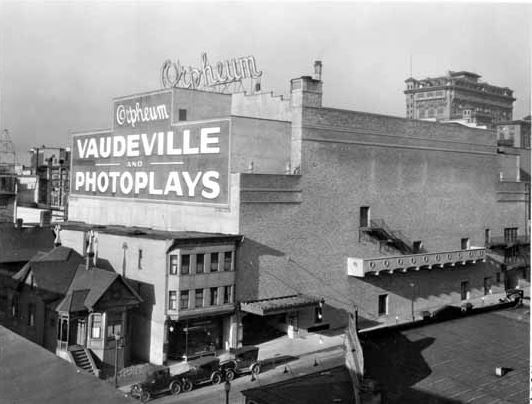
Dan Rickard photography
A couple of weeks ago, Judy Graves, Tom Carter and I took a behind-the-scenes tour of the Orpheum Theatre.
The “new” Orpheum was designed in 1927 by Marcus Priteca, a Seattle-based architect who fashioned the theatre in a Spanish renaissance style and gave it an opulent air with some sleight of hand tricks.
For instance, if you tap on a colonnade it’s hollow, made from precast plaster. The ornate Baroque ceiling is made from plaster and chicken wire.
Priteca introduced a range of different influences including Italian-inspired terrazzo floors and travertine walls, crests of British heraldry and 145 Czechoslovakian crystal chandeliers.

We got to climb up on a catwalk way above the domed ceiling, visit the projection booth—and we went up on the stage—the same one where Jack Benny and W.C. Fields once performed.
Tom played the original organ.
I didn’t realize how close we came to losing the theatre. In 1973 Famous Players wanted to replace the Orpheum with a Multiplex cinema and it sparked off what was probably the biggest heritage protest in Vancouver’s history. City Hall received 8,000 letters from angry citizens and petitions with thousands of signatures. Ivan Ackery, the Orpheum’s long-time manager bounced back from retirement and joined impresario Hugh Pickett to stage a benefit concert.
The City bought the Orpheum for $3.9 million and poured another $3.2 million into a renovation by Paul Merrick, the same architect who designed Cathedral Place, renovated the Marine Building and converted the BC Electric building into the Electra.
“The Orpheum is a good example of a building that has begged, borrowed and stolen characteristics from all over the world,” Merrick told me. “There’s a dozen different styles going on top of each other, from Spanish to late Edwardian to who knows what, it was just a case of playing some more with it.”
Merrick said the Orpheum was one of “the earliest large adaptive reuse projects” and was more extensive then it appears because the whole of the Vaudeville stage entrance was taken out and redone using a larger version of Priteca’s original design to accommodate a 100-plus orchestra.
“Adapting buildings involves paying all the respect and every respect you can to what it is and what it was and why it’s worth taking trouble with, but that doesn’t mean being stultified or precious about it,” he said. “The focus of architecture is to make a building and when it’s all said and done, buildings need to be objects of utility, to service the people’s uses and needs inside them. They are there to provide shelter, but they are also concerned with affording delight. I always thought if you could make pieces of the city—which is all a building is just another piece of the city—if we can make an environment that we’re happy to leave to our descendants, then that’s as good as you can do.”





6 comments on “The Orpheum Theatre and a conversation with Paul Merrick”
I took a tour of the Orpheum a few years back and it was exciting to see it in a whole different light from being a spectator in the audience. The tour was given by someone who was involved with the Orpheum for a good number of years — it wasn’t Hugh Pickett but a contemporary of his. We did all the things you mentioned and he also took us up to the dressing rooms that were up a long flight of stairs and then had us run down the stairs as quick as we could saying that’s what the performers had to do. It was interesting to learn how the theatre was actually on Seymour Street but the entrance was on Granville so that it was less expensive/lower taxes, etc. Until he pointed that out, I hadn’t really figured that out after years of entering on Granville, going up the stairs and across. It’s a great tour.
i love Spanish architecture .. most of the building in our place such as this have a touch of Spanish designers.. though its 2014 already but i would still go around places like this… nothing beats well-design theatre…
Our very own “Phantom of the Opera” setting!!
I love the historic photo above: the Victorian house, the Edwardian apartment building and the theatre (with the Hotel Vancouver in the distance). The evolution of a neighbourhood. When I was a child, I thought that just entering the Orpheum was magical. The lobby, the climb up the stairs and the long corridor, then the descent into the lobby before entering the theatre. I didn’t realize until much later that the long corridor was a catwalk over the lane. Placing the narrow frontage on Granville and the bulk of the theatre on cheaper Seymour Street was a stroke of genius. A couple of years ago, we walked to Priteca’s Pantages theatre at Hollywood and Vine, but didn’t see the interior.
[…] Paul Merrick, designed Cathedral Place, renovated the Marine Building, the Orpheum Theatre, and converted the old BC Hydro Building to the Electra. I quite like Cathedral Place. It’s nicely tiered, the roof fits in with the Hotel Vancouver across the street, and it even has a few nurses, gargoyles and lions pasted about as a reminder of the former building. Everyone over 35 likely remembers the three nurses in their starchy World War 1 uniforms looking down from their 11th storey parapets. Known as the Rhea Sisters, the terra-cotta statues weighed several tonnes each. Later restored, the nurses are part of the Technology Enterprise Facility building at UBC. […]
[…] and mentored some of our most influential West Coast Modern architects. Arthur Erickson, Ron Thom, Paul Merrick, Barry Downs and Fred Hollingsworth all cut their teeth at TBP, and BC Binning consulted on much of […]